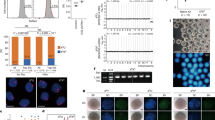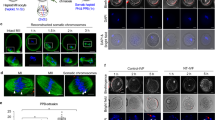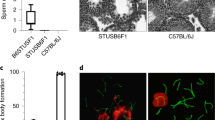Abstract
INDIRECT evidence of the capacity of a Y-containing germ cell to become functional oocyte in ovarian tissue of a chimaeric XX/XY female mouse has been published1. This animal was one of two fertile XX/XY females obtained by aggregation of early morulae of the inbred strains AKR (albino) and CBA-T6 (agouti). Mated to a BALB/c (albino) male she had given birth to two litters that included one albino son, the remaining six young being agouti. Afterwards she had been retained for observation in connection with another investigation. In consequence she was more than 12 months old when her chromosomes were examined and she was found to contain both XX (CBA) and XY (AKR) cells. Only then was it realised that this implied that the egg that gave the albino son had come from a Y-bearing oocyte. Although ancillary evidence effectively excluded the possibility of erroneous recording or mixture of animals as explanations, there may have been some reluctance to accept the conclusion that a Y-bearing germ cell had become a functional oocyte. It is therefore satisfying to report here the direct observation of an XY oocyte at diakinesis in a preparation from another fertile, chimaeric XX/XY female mouse.
This is a preview of subscription content, access via your institution
Access options
Subscribe to this journal
Receive 51 print issues and online access
$199.00 per year
only $3.90 per issue
Buy this article
- Purchase on Springer Link
- Instant access to full article PDF
Prices may be subject to local taxes which are calculated during checkout
Similar content being viewed by others
References
Ford, C. E. et al. Proc. R. Soc. B 190, 187–197 (1975).
Lyon, M. F., Glenister, P. H. & Lamoreux, M. L. Nature 258, 620–622 (1975).
Tarkowski, A. K. Cytogenetics 5, 394–400 (1966).
Edwards, R. G. Nature 208, 349–351 (1965).
Mullen, R. J. & Whitten, W. K. J. exp. Zool. 178, 165–176 (1971).
Mystkowska, E. T. & Tarkowski, A. K. J. Embryol. exp. Morph. 20, 33–52 (1968).
Mystkowska, E. T. & Tarkowski, A. K. J. Embryol. exp. Morph. 23, 393–405 (1970).
Milet, R. G., Mukherjee, B. B. & Whitten, W. K. Can. J. gen. Cytol. 14, 933–941 (1972).
McLaren, A. J. Embryol. exp. Morph. 33, 205–216 (1975).
Ford, C. E. et al. Differentiation 2, 321–333 (1974).
McLaren, A. Mammalian Chimaeras 46 (Cambridge University Press, Cambridge, London & New York, 1976).
Epstein, C. J. Science 163, 1078–1079 (1969).
Gartler, S. M., Liskay, R. M., Campbell, B. K., Sparkes, R. & Grant, N. Cell Differ. 1, 215–218 (1972).
Burgoyne, P. S. & Biggars, J. D. Devl Biol. 51, 109–117 (1976).
Gordon, J. J. exp. Zool. 198, 367–374 (1976).
Author information
Authors and Affiliations
Rights and permissions
About this article
Cite this article
EVANS, E., FORD, C. & LYON, M. Direct evidence of the capacity of the XY germ cell in the mouse to become an oocyte. Nature 267, 430–431 (1977). https://doi.org/10.1038/267430a0
Received:
Accepted:
Issue Date:
DOI: https://doi.org/10.1038/267430a0
This article is cited by
-
Single-cell RNA sequencing reveals regulation of fetal ovary development in the monkey (Macaca fascicularis)
Cell Discovery (2020)
-
ALDH1A1 provides a source of meiosis-inducing retinoic acid in mouse fetal ovaries
Nature Communications (2016)
-
Male, female and intersex development in mice of identical chromosome constitution
Nature (1982)
-
Fertile females produced by inactivation of an X chromosome of ‘sex-reversed’ mice
Nature (1982)
-
Oocytes in the testis
Nature (1980)
Comments
By submitting a comment you agree to abide by our Terms and Community Guidelines. If you find something abusive or that does not comply with our terms or guidelines please flag it as inappropriate.



